Results 1-46 of 46
<<< Previous 1 Next >>>
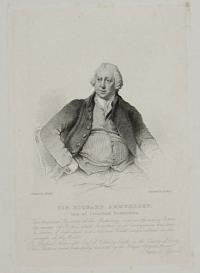
Sir Richard Arkwright, late of Cromford Derbyshire, The Eminent Inventor of the Machinery used in Spinning Cotton, by means of Rollers [...]
Painted by J. Wright Engraved by H. Meyer [c.1800]
Stipple engraving on india, platemark 225 x 150mm (9 x 6") very large margins.
Sir Richard Arkwright (1732-92), inventor of cotton-spinning machinery and cotton manufacturer. The archetypal self-made man, Arkwright went from a barber's apprentice in Bolton to a key figure in the proto-industrial north and midlands whose worth at his death was some £500,000. An ambitious inventor, Arkwright improved cotton manufacturing machinery, set up up the Cromford Cotton Mills in the then unexploited district of Cromford near Matlock (for a view of pre-Arkwright Cromford see ref.29386), and later ventured into hosiery knitting as well. Engraving after the portrait of c.1789-90 by Joseph Wright of Derby (private collection). Arkwright occupies an important place in Wright's work, not only in the portraits he painted of Arkwright and his family, but also because of the series of views he painted of the area where Arkwright established his empire. Not shown in this engraving is the model of the spinning frame Arkwright claimed to have invented, which in Wright's painting is on a table beside the sitter's left hand. Benedict Nicolson suggests that because aspersions had been cast on his qualifications as an inventor, Arkwright preferred to have this aspect of his work emphasised, rather than being painted with, say, a plan of his industrial empire- an achievement which was in no doubt. Nicolson, 'Joseph Wright of Derby: Painter of Light' (1968), vol. 1, pp.164-9. For Nicolson's monograph see ref. 27349.
[Ref: 41078] £120.00
(£144.00 incl.VAT)
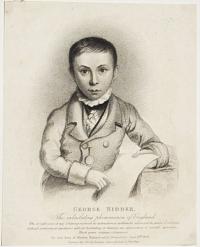
George Bidder. The Calculating phenomenon of England. Who at eight years of age & having received no instruction ina rthmatic possessed the power of resolvin difficult arithmetical questions without hesitatin or shewing any appearance if mental operation Which power continues and improves. He was born at Morton Hampstead in Devonshire June 14.th. 1806.
Engraved July 1815 by Freeman from a picture by John King.
Stipple. Sheet: 155 x 195mm (6 x 7¾"). Trimmed within plate.
A portrait of George Bidder (1806-1878) who was exhibited by his father around the country on account of his fascinating mental skills. Thanks to an education provided by figures such as Sir J. Herschel and Sir H. Jardine, Bidder went on to be a successful engineer who worked alongside the Stephensons advising on the creation of the railways. For a portrait of Bidder as an adult see ref: 3964. For another portrait of Bidder as a boy see ref: 31184.
[Ref: 35729] £95.00
(£114.00 incl.VAT)

George P. Bidder, Esqre.
Painted & Engraved by John Lucas. Proof.
London: Published January 1st. 1848, By Henry Graves & Compy. Printsellers To The Queen & H.R.R. Prince Albert, 6.Pall Mall.
Mezzotint. 518 x 360mm.
George Parker Bidder (1806-1878).was the son of a stonemason and born at Mortonhampstead in Devon. While still a young child his father took him to local fairs and then around the country showing off his mathematical skills where he earned a good living. In 1819 he came to the attention of Sir Henry Jardine and was tutored privately, by 1820 he was attending Edinburgh University. He settled in Lambeth and became a very successful engineer.
[Ref: 3964] £320.00
![Matth:w Boulton [facsimile signature.]](img-thumbnail/jpegs/26644.jpg)
Matth:w Boulton [facsimile signature.] 24th June 1787.
From a Wax Medallion modelled from life in the possession of Mr. John Rabone Junr.
Photographed by Mr. H.J. Whitlock, Birm.m.
Photograph. 222 x 145mm. 8¾ x 5¾".
Matthew Boulton (1728-1809) the Birmingham industrialist and entrepreneur, who was called 'the first manufacture in England' by Josiah Wedgwood. He was the founder of the Soho Works in Birmingham in 1762, known for its high quality ornamental objects.
[Ref: 26644] £130.00
(£156.00 incl.VAT)
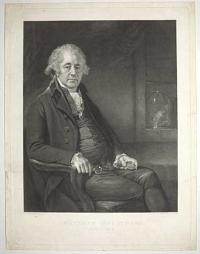
Matthew Boulton, Esq. F.R.S. & F.S.A.
Sir William Beechey pinx.t. Will.m Sharp sculp.t.
Published May 1 1801 by W.m Sharp, London.
Engraving. 525 x 390mm (20¾ x 15½"). Tears entering plate repaired, creasing. Small margins.
Matthew Boulton (1728-1809) the Birmingham industrialist and entrepreneur, who was called 'the first manufacturer in England' by Josiah Wedgwood. He was the founder of the Soho Works in Birmingham in 1762, known for its high quality ornamental objects. In 1775 Boulton entered into partnership with the Scottish engineer James Watt who invented the steam engine; he supplied machinery for the new Mint on Tower Hill in 1805. Boulton also designed for the commercial art market, devising ormolu (gilt brass) mounts for the English potter Josiah Wedgwood's decorative wares. Both men belonged to the Lunar Society, a group of prominent Midlands men who developed ideas and techniques in science, manufacturing and transport. W: 385.
[Ref: 59134] £380.00
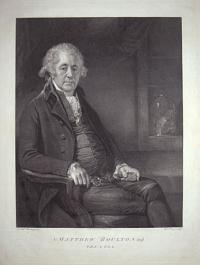
Matthew Boulton, Esq. F.R.S. & F.S.A.
Sir William Beechey pinx.t. Will.m Sharp sculp.t.
Published May 1 1801 by W.m Sharp, London.
Fine engraving. 525 x 390mm (20¾ x 15½") large margins. Backed with newspaper.
Matthew Boulton (1728-1809) the Birmingham industrialist and entrepreneur, who was called 'the first manufacturer in England' by Josiah Wedgwood. He was the founder of the Soho Works in Birmingham in 1762, known for its high quality ornamental objects. In 1775 Boulton entered into partnership with the Scottish engineer James Watt who invented the steam engine; he supplied machinery for the new Mint on Tower Hill in 1805. Boulton also designed for the commercial art market, devising ormolu (gilt brass) mounts for the English potter Josiah Wedgwood's decorative wares. Both men belonged to the Lunar Society, a group of prominent Midlands men who developed ideas and techniques in science, manufacturing and transport. W: 385.
[Ref: 52083] £320.00

Mr James Brindley Engineer to his Grace the Duke of Bridgewater and to the Canal Navigations now Carrying on in different parts of the Kingdom.
F. Parsons Pinxt. R. Dunkarton fecit 1773.
[c.1820.]
Mezzotint, 455 x 330mm. 18 x 13".
James Brindley (1716 - 1772), early civil engineer and canal builder, famous for the Bridgwater Canal and the viaduct where the canal went above a river (background to left). His right arm rests on a telescope. A later impression from the plate first published 1770, on wove paper, probably from the two volume folio 'Woodburn’s Gallery of rare Portraits, consisting of original plates, by Cecil, Deloram, Droeshout, Elstracke, Faithorne, ... &c' 1816. After Francis Parsons (1763 - 1804). British Library: 003970702.
[Ref: 11734] £280.00
(£336.00 incl.VAT)
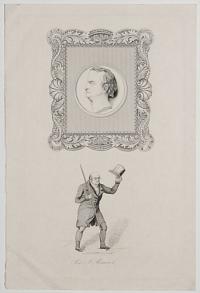
Sir I. Brunel.
[n.d., c.1850.]
Engraving. Plate: 230 x 140mm (9 x 5½"). Crease in bottom right corner.
Two portraits of mechanical and civil engineer Isambard Kingdom Brunel (1806-1859), on the top is depicted a profile bust of while below Brunel is shown raising his well-known tall hat.
[Ref: 46826] £70.00
(£84.00 incl.VAT)
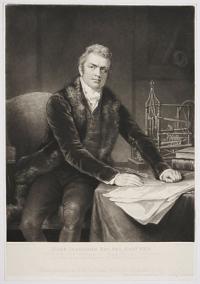
Mark Isambard Brunel Esq.r F.R.S. Author of the Block Machinery in his Majesty's Dock Yard at Portsmouth, and of other eminent works belonging to the British Government, &c. &c. Dedicated by permission to the R.t Hon.ble Lord Viscount Melville, First Lord of the Admiralty, &c. &c. &c. by his Lordship's most ob.t. & hum.ble s.t Chas. Turner.
Painted by James Northcote Esq.r R.A. Engraved by C.Turner.
London. Pub.d. March 30th, 1815 by C.Turner, 50, Warren Street, Fitzroy Square.
Mezzotint on chine collé. 505 x 355mm (19¾ x 14").
Sir Marc Isambard Brunel (1769-1849), civil engineer, at a table with mechanical drawings and a model of an engine His method for production of rigging blocks for the navy at the Portsmouth Block Mills was the first genuine industrial production line. He is remembered for being chief engineer on the Thames Tunnel and as father of Isambard Kingdom Brunel, but also served as chief engineer in New York, and designed Liverpool's first floating landing stage (1826). Engraved after the portrait of 1812-13 by James Northcote (National Portrait Gallery). Whitman 77 iii/iii; Ex: Collection of the Late Hon. C. Lennox-Boyd. For an earlier state, see ref. 4429.
[Ref: 34839] £360.00
![[John Buddle, Esq.r.]](img-thumbnail/jpegs/57096.jpg)
[John Buddle, Esq.r.]
Painted by Tho.s Carrick. Engraved by Edw.d MacInnes.
Published Aug.t 20. 1836, by Hodgson & Graves, London; Currie & Bowman, Newcastle.
Mezzotint, proof before title, printed on chine collé. 365 x 260mm (14½ x 10¼"). Buddle's name in old ink mss (signature?), a little wear.
Half-length portrait of John Buddle (1773-1843), sitting at a table with a cog mechanism on it, holding a Davy lamp. As manager of the Wallsend colliery helped introduce Humphrey Davy's safety lamp. He also helped design the pioneering locomotive 'Steam Elephant' for Wallsend Colliery.
[Ref: 57096] £450.00
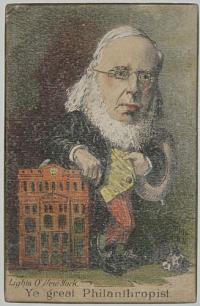
Ye great Philanthropist. Lights O' New York.
Tobin. N.Y. [n.d. c.1880.]
Chromolithograph. 158 x 102mm. 6¼ x 4".
Peter Cooper (1791-1883) was an American inventor, industrialist, and philanthropist born in New York City. In 1829, after much success in the glue business, he erected the Canton Iron Works in Baltimore. There he constructed the "Tom Thumb", one of the earliest locomotives built in the United States. His lasting monument is Cooper Union in New York City, built after his own plans to provide for education for the working classes.
[Ref: 15454] £60.00
(£72.00 incl.VAT)
![W. Cubitt [facsimile signature]](img-thumbnail/jpegs/4010.jpg)
W. Cubitt [facsimile signature]
T. H. Maguire. 1850. M. & N. Hanhart Impt.
[Published by George Ransome, Ipswich, n.d. c.1850]
Lithograph with facsimile signature. 609 x 446mm.
Civil Engineer and builder of railways, 1785-1861, inventor of the treadmill, He superintended the construction of the Crystal Palace for the Great Exhibition of 1851. This print published for Ipswich Museum Portraits.
[Ref: 4010] £160.00
(£192.00 incl.VAT)
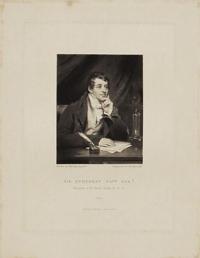
Sir Humphrey Davy Bar.t President of the Royal Society &c &c &c
Painted by T. Phillips Esq.r R.A. Engraved by S.W. Reynolds
Pub.d by T. Phillips March 1822
Mezzotint with large margins, proof; platemark 230 x 165mm (9 x 6½"). Rare.
Sir Humphry Davy (1778-1829), chemist and inventor. He is remembered mainly for his discoveries of several alkali and alkaline earth metals, as well as his contributions to the discoveries of the elemental nature of chlorine and iodine. In 1815 he invented the Davy lamp, which allowed miners to work safely in the presence of flammable gases. Davy's reputation was soon eclipsed by that of his one-time assistant Michael Faraday, but Davy was one of the first professional men of science, with a high position and great fame in his own day. Engraved after the portrait by Thomas Phillips (1770-1845), whose over 700 portraits record the leading personalities of his time Ex: Collection of the Late Hon. C. Lennox-Boyd; W 68; Wellcome: 772-15.
[Ref: 34954] £220.00
(£264.00 incl.VAT)
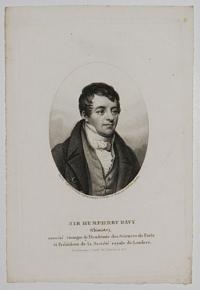
Sir Humphrey Davy (Chimiste), associé etranger de l’Académie des Sciences de Paris et Président de la Société royale de Londre. Ne à Penzance Comté de Cornwall en 1775.
Dessiné d’après le Portrait original peint par T. Phillips, et Gravé par Ambroise Tardieu.
[n.d. c.1830.]
Stipple with small margins. Plate 196 x 127mm (7¾ x 5").
Sir Humphrey Davy (1778-1829), English chemist and inventor. He is remembered mainly for his discoveries of several alkali and alkaline earth metals, as well as his contributions to the discoveries of the elemental nature of chlorine and iodine. In 1815 he invented the Davy lamp, which allowed miners to work safely in the presence of flammable gases. W.772 - not in.
[Ref: 29590] £50.00
(£60.00 incl.VAT)
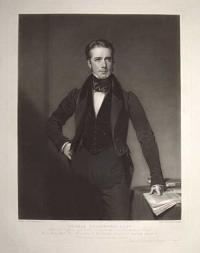
Thomas Drummond, Esq.r Captain of Engineers, and Under Secretary to the Lord Liuetenant of Ireland, To the Most Noble The Marquis of Normanby, this plate is respectfully dedicated by His Lordship's obedient humble Servants, Paul & Dominic Colgnaghi & Comp.y.
Painted by H.W. Pickersgill, R.A. Engraved by Henry Cousins.
Published at No. 14 Pall Mall East, June 20th. 1841, by Paul & Dominic Colnaghi & Co. Print Publishers to Her Majesty.
Rare and fine mezzotint, plate 505 x 380mm (19¾ x 15"), very large margins.
Three-quarter length standing portrait of Thomas Drummond (1797-1840) facing the front, leaning with his left fist on papers on a table to right, with two books behind it, left hand on his hip, looking ahead and to right, wearing a dark tail-coat suit, velvet waistcoat, jacket collar and bow-tie and wing collar. He was was a Scottish army officer, civil engineer and senior public official. He used the Drummond light which was employed in the trigonometrical survey of Great Britain and Ireland. He is sometimes mistakenly given credit for the invention of limelight, at the expense of Sir Goldsworthy Gurney (1793 –1875). It was Drummond, however, who realised its value in surveying.
[Ref: 59037] £320.00
![Peter Ewart [facsimile signature]. Private Plate[lower left].](img-thumbnail/jpegs/3953.jpg)
Peter Ewart [facsimile signature]. Private Plate[lower left].
Painted by James Lonsdale. Engraved by S.W. Reynolds. 151/2 Holland St. Kensington.
Published by Thomas Agnew, Repository of Arts Exchange St. Manchester, July 8th 1843. Printed by Brooker & Harrison.
Mezzotint engraving on india paper. 305 x 405mm.
Engineer who was influential in developing the technologies of turbines and theories of thermodynamics [1767 - 1842].
[Ref: 3953] £260.00
(£312.00 incl.VAT)
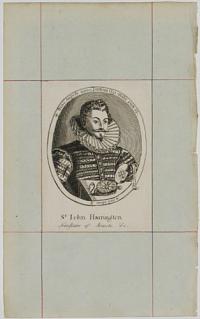
Sir John Harrison Translator of Aristo_ &c. Promo Augusti anno Domini 1591 ætatis suæ 30.
[n.d. c.1800.]
Etching. Sheet 100 x 75mm (4 x 3"). Trimmed and laid on album paper.
Oval portrait of John Harington (c.1561-1612), courtier of Elizabeth I, author and reputed inventor of the flush toilet, a clock in the background. His translation of Ariosto's 'Orlando Furioso' caused his banishment from court. He installed his flush toilet, called 'Ajax' (a pun on the slang 'jakes' for toilet) at his manor in Kelston and published a humorous book, under the pseudonym of Misacmos, called 'A New Discourse upon a Stale Subject: The Metamorphosis of Ajax'.
[Ref: 37796] £75.00
(£90.00 incl.VAT)
![[John Hawkshaw.]](img-thumbnail/jpegs/8207.jpg)
[John Hawkshaw.]
[Painted by James Edgell Collins. Engraved by James Faed.]
[London, Published March 16th 1866 by Henry Graves & Co. the Proprietors Publishers to the Queen and T.R.H. the Prince & Princess of Wales__6 Pall Mall.]
Mezzotint, proof before letters. 405 x 515mm. Some staining in margins.
Sir John Hawkshaw, engineer who in 1845 became chief engineer to the Manchester & Leeds railway, and in 1847 to its successor, the Lancashire & Yorkshire railway 1811 - 1891].
[Ref: 8207] £240.00
(£288.00 incl.VAT)
![[Thomas Hawksley] T. Hawksley [facsimile signature.]](img-thumbnail/jpegs/47445.jpg)
[Thomas Hawksley] T. Hawksley [facsimile signature.]
Hubert Herkomer. Frank Sternberg. [pencil signatures.]
[n.d., 1889.]
Mezzotint on chine collé, signed by the artist and engraver. 560 x 440mm (22 x 17¼") Titled in later pencil, damp staining in margins
A seated portrait of Thomas Hawksley (1807-93), F.R.S., painted as past President of the Institution of Civil Engineers. Specialising in water and gas supply, he was the first engineer to adopt pressure grouting to control water leakage under an embankment dam for reservoirs. The original oil, painter by Hubert von Kerkomer in 1887, was donated to the National Portrait Gallery by his son in 1974. See NPG 4973.
[Ref: 47445] £160.00
(£192.00 incl.VAT)
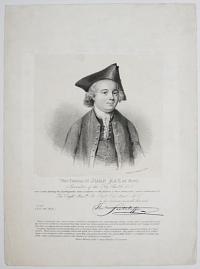
This Portrait of John Kay, of Bury, (Inventor of the Fly Shuttle &c), was saved, during the Earthquake that occurred on the Island of Juan Fernandes, and is dedicated to The Right Hon.ble Sir Rob.t Peel Bart. M. by his obedient, humble Servant, Tho.s Sutcliffe.
Proof. (Ent. Sta. Hall.) Madeley lith, 3 Wellington St. Strand.
Baines History of the County Palatine of Lancaster.
Lithograph, printed on india. Sheet: 380 x 280mm (15 x 11").
A bust portrait of John Kay (1704-1779) who invented the flying shuttle which was one of the most important inventions of the Industrial Revolution.
[Ref: 46313] £190.00
(£228.00 incl.VAT)
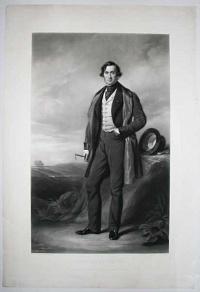
Joseph Locke, Esq.re M.P.
Painted by Francis Grant, Esq. A.R.A. Engraved by Henry Cousins.
London, Published June 1st. 1849, by Henry Graves & Comp.y Printsellers in Ordinary to Her Majesty and H.R.H. Prince Albert. 6, Pall Mall.
Mixed method engraving. Plate 774 x 394mm. 30½ x 15½".
Joseph Locke (1805-1860) was a civil engineer and was apprenticed to the railway engineer George Stephenson. He was particularly associated with railway projects and dominated this scene alongside Robert Stephenson and Brunel, as one of the major pioneers of railway development. He was part of the surveying team and group of engineers on the developments of the Liverpool & Manchester Railway, Lancaster & Carlisle Railway, and the Manchester & Sheffield Railway. In the south he was responsible for working on the London and South Western Railway, including the designs of Richmond Railway Bridge (1848, but since replaced) and Barnes Bridge (1849). He was also involved in planning and building many railways in Europe, including the Le Havre, Rouen, Paris rail link, the Barcelona to Mataro line and the Dutch Rhenish Railway. Between 1857 and 1859 he was President of the Institution of Civil Engineers and in 1847 he served as MP for Honiton in Devon. Science Museum: 10302032.
[Ref: 19178] £420.00
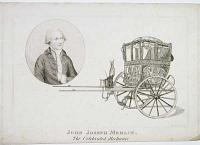
John Joseph Merlin, The Celebrated Mechanic.
G.P.H. delt. et Sculp.
[n.d., c.1815.]
Stipple with etching. 140 x 215mm (5½ x 8½"). Trimmed into lower edge of plate.
John-Joseph Merlin was born in 1735 in the city of Huy, Belgium, and died in 1803 in London. He was an inventor, noted for the invention of roller skates. He also improved musical instruments and manufactured automats, such as Cox's timepiece. He created Merlin's Mechanical Museum to display his machines. Probably by George Perfect Harding (1781 - 1853), portrait painter, copyist and antiquary.
[Ref: 7523] £75.00
(£90.00 incl.VAT)
![W.H. Phillips [facsimile signature]](img-thumbnail/jpegs/35334.jpg)
W.H. Phillips [facsimile signature] Inventor of the Fire Annihilator.
Alfred Tidey, Pinx.t. William Underwood, Litho. Printed by Hullmandel & Walton.
Published June 10th 1852, by J.L. Grundy, 130, Regent St.
Lithograph on india with back-sheet printed with title; extremely rare. Sheet 470 x 350mm (18½ x 13¾"). Some spotting, corner creased.
Half-length portrait of William Henry Phillips, whose 'Patent portable fire annihilator, for extinguishing fire by gases and vapour, affording a means of saving life and property when water may be unavailing' was exhibited at the Great Exhibition of 1851, winning a prize. This was a device that used a chemical reaction to produce a cloud of carbon dioxide to smother a fire. A motion was presented to Parliament that every government vessel should have an Annihilator. However the Fire Annihilator Works, at Battersea Fields, burned to the ground in 1852, and the business failed. P.T. Barnum invested in the company that bought the American patent, but after some unsatisfactory trials, that company also closed, although the Great American Showman still believed the invention was a valuable one, writing about it in his autobiography. Not in Wellcome.
[Ref: 35334] £360.00
![[James Meadows Rendel, F.R.S.]](img-thumbnail/jpegs/22531.jpg)
[James Meadows Rendel, F.R.S.]
[Painted by G.Opie, engraved by Samuel Bellin.]
[Henry Graves & Co, 1866.]
Mezzotint on india, proof before letters, Printsellers' Association blindstamp. Plate 518 x 411mm. 20½ x 16¼". Scarce, bit dirty, with large margins.
James Meadows Rendel (1799-1856), civil engineer. Rendel was employed by Thomas Telford before setting up his own business in Plymouth. His greatest enterprises were the harbours at Holyhead (1845), Portland (1847) and St. Peter Port, Guernsey (1850). He was President of the Institution of Civil Engineers, 1852-3. In 1831 he introduced a new system of crossing rivers by means of chain ferries worked by steam, and in 1832 he constructed a floating bridge on this principle, crossing the Dart at Dartmouth. Between 1832 and 1834 similar floating bridges were erected at Torpoint and Saltash across the Tamar, which greatly facilitated the intercourse between Devon and Cornwall. PSA: AP.25. BL.25.
[Ref: 22531] £280.00
(£336.00 incl.VAT)
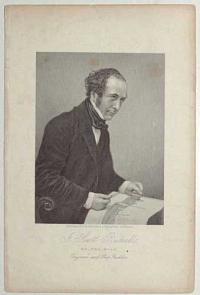
J. Scott Russell M.A._F.R.S._M.I.C.E. Engineer and Ship Builder.
Engraved by W. H. Mote, from a Photograph by Mayall
[n.d., c.1850]
Rare engraving and stipple, plate 185 x 120mm (7¼ x 4¼"). Some creasing and time staining with tears to edges.
A half-length seated portrait of John Scott Russell with an engineering plan on his knee. John Scott Russell (1808-1882) was a Scottish civil engineer, naval architect and shipbuilder who built Great Eastern in collaboration with Isambard Kingdom Brunel (1806-1859). He made the discovery of the wave of translation that gave birth to the modern study of solitons, and developed the wave-line system of ship construction.
[Ref: 55996] £80.00
(£96.00 incl.VAT)
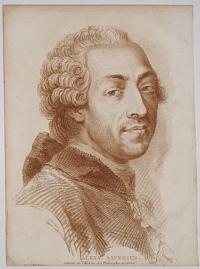
Alexa. Saverien. Auteur de l'Histoire des Philosophes modernes... &c&c.
Peint par Mdme. François.
[Paris: J.C. François, c.1760.]
Crayon manner printed in reddish-brown ink, sheet 295 x 220mm. 11½ x 8¾".
Portrait of Alexandre Savérien (1725 - 1805), French engineer and author of the book in which this plate was published, 'Histoire des Philosophes modernes' (eight 4to vols, Brunet 1760-1767). 79 plates (and eight frontispieces) were engraved for the book. By Jean Charles François (1717 - 1769), inventor the crayon manner technique of etching in 1757; apparently after his own wife's design.
[Ref: 22214] £180.00
(£216.00 incl.VAT)
![William Siemens [facsimile signature].](img-thumbnail/jpegs/43389.jpg)
William Siemens [facsimile signature].
Rudoph Lehmann pinx. Swan Electric Engraving Co.
[n.d., c.1883.]
Photogravure. 220 x 170mm (8½ x 6¾"), very large margins with a sheet of letterpress biography. Slight foxing.
Half-length portrait of Sir Charles William Siemens (originally Karl Wilhelm, 1823-83), electrical engineer and entrepreneur. Godalming in Surrey had the world's first street lighting, powered by a Siemens AC Alternator driven by a watermill. Rudolf Lehmann's oil, painted in 1882, in in the National Portrait Gallery. NPG 2632.
[Ref: 43389] £75.00
(£90.00 incl.VAT)

John Smeaton. Civil Engineer. F.R.S. Died Oct. 28. MDCCLXXXXII Aged 68 Years.
Painted by Mr. Brown for Al.r Aubert Esquire. Engraved by Mr. Bromley and Published for the Society of Civil Engineers, by W. Faden Feb. 1st 1798
Engraving, platemark 215 x 165mm (8½ x 6½") large margins.
John Smeaton (1724-92), civil engineer, portrayed here with Eddystone Lighthouse (which he designed in 1755-9) in the background. Smeaton was responsible for numerous bridges, canals and harbours.
[Ref: 43613] £90.00
(£108.00 incl.VAT)
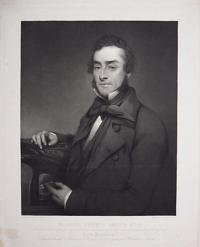
Francis Pettit Smith Esq.r To whose talent & untiring energies the World at large is indebted for the first, practical introduction of the system of Screw Propulsion, Into the Naval & Merchant Services of all its greatest Matatime Nations. Proof.
Painted by William Boxall A.R.A. [...] Engraved by Sydney Marks
[c.1860]
Rare open-letter proof mezzotint. Platemark 460 x 365mm (18 x 14¼"), large margins on two sides.
Sir Francis Pettit Smith (1808-74), inventor of the screw propellor. An enthusiastic builder of model boats as a boy, by 1835 Smith had built a model propelled by a screw, powered by a spring, which he believed would be more efficient than the paddle wheel then universally used by steamships. The following year Smith took out a patent for screw propulsion, and applied his technology to progressively larger vessels. The Admiralty persuaded Smith to build a large ship, the 'Archimedes' (the name is inscribed on the propellor visible in this portrait), but eventually declined to purchase it, leading to the failure of Smith's company. Smith's friends rallied around him, however, and secured him a civil-list pension and the post of director of the Patent Office museum. Smith was knighted in 1871. Fine mezzotint after the portrait by William Boxall now in the Science Museum.
[Ref: 47674] £350.00
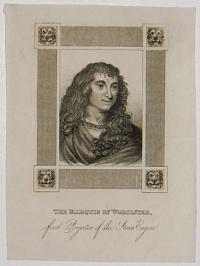
The Marquis of Worcester, first Projector of the Steam Engine.
[Anon, c.1830]
Stipple engraving, sheet 125 x 95mm (5 x 3¾"). Trimmed inside platemark.
Edward Somerset, second marquess of Worcester (d.1667), courtier and scientist. Worcester was a scientific entrepreneur who imaginatively patronised hydraulic engineering, but was unable to convince the scientific community of his achievement, and it was left to the Victorians (exemplified by this print) to rescue his reputation as an engineer. He was also a war commander in the Welsh marches, and a diplomat in Ireland.
[Ref: 35313] £70.00
(£84.00 incl.VAT)
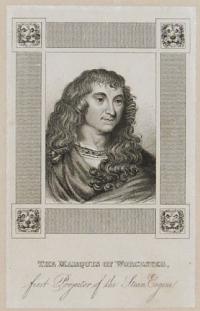
The Marquis of Worcester, first Projector of the Steam Engine.
[Anon, c.1830]
Stipple engraving, sheet 115 x 70mm (4½ x 2¾"). Trimmed to image; false margins added.
Edward Somerset, second marquess of Worcester (d.1667), courtier and scientist. Worcester was a scientific entrepreneur who imaginatively patronised hydraulic engineering, but was unable to convince the scientific community of his achievement, and it was left to the Victorians (exemplified by this print) to rescue his reputation as an engineer. He was also a war commander in the Welsh marches, and a diplomat in Ireland.
[Ref: 35314] £60.00
(£72.00 incl.VAT)
![GW: Stephenson Engineer. [facsimile signature]](img-thumbnail/jpegs/946.jpg)
GW: Stephenson Engineer. [facsimile signature]
Painted By H. P. Briggs, Esqr: R.A. Engraved By C. Turner, A.R.A.
London, Published for the Proprietor June 7, 1838, by Mr. Turner, 50 , Warren Street, Fitzroy Square.
Mezzotint. 419 x 313mm. Repaired hole, creases and tears within the plate margin.
George Stephenson (9 June 1781 – 12 August 1848) was an English mechanical engineer who designed a famous and historically important steam-powered locomotive named Rocket and is known as the 'Father of British Steam Railways'. The Victorians considered him a great example of diligent application and thirst for improvement, with self-help advocate Samuel Smiles particularly praising his achievements. His rail gauge of 4 ft 8½ in (1435 mm), originally called 'Stephenson gauge', has become the standard gauge for the majority of the world's railways.
[Ref: 946] £180.00
(£216.00 incl.VAT)
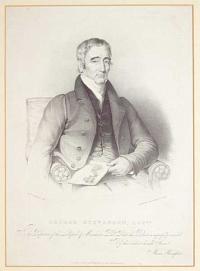
George Stevenson, Esq.re. To the Proprietors of the Liverpool & Manchester Rail Road, this Portrait is respectfully inscribed By their obedient and humble Servant Moses Haughton.
Moses Haughton del.t. Engelmann, Graf, Coindet & Co. lithog.
London: Published by M. Haughton, 51 Great Marlborough St. [n.d. c.1820]
Scarce lithograph sheet 370 x 270mm (14½ x 10½"). Tapped into mount.Some surface dirt and very light foxing.
Half-legth seated portrait of English civil & mechanical engineer "Father of Railways", George Stephenson (1781 – 1848), he holds a picture of a train in his left hand. He wears a waistcoat, cravat and double breasted jacket.
[Ref: 58919] £260.00
(£312.00 incl.VAT)
![GW: Stephenson Engineer. [facsimile signature]](img-thumbnail/jpegs/947.jpg)
GW: Stephenson Engineer. [facsimile signature]
Painted By H. P. Briggs, Esqr: R.A. Engraved By C. Turner, A.R.A.
London, Published for the Proprietor June 7, 1838, by Mr. Turner, 50 , Warren Street, Fitzroy Square.
Mezzotint. 419 x 313mm. Very mild stain from old mount, crack in platemark, small hole reinforced.
George Stephenson (9 June 1781 – 12 August 1848) was an English mechanical engineer who designed a famous and historically important steam-powered locomotive named Rocket and is known as the 'Father of British Steam Railways'. The Victorians considered him a great example of diligent application and thirst for improvement, with self-help advocate Samuel Smiles particularly praising his achievements. His rail gauge of 4 ft 8½ in (1435 mm), originally called 'Stephenson gauge', has become the standard gauge for the majority of the world's railways.
[Ref: 947] £380.00
![Geo Stephenson [facsimile signature].](img-thumbnail/jpegs/3966.jpg)
Geo Stephenson [facsimile signature].
[Painted by J. Lucas. Engraved by T.L. Atkinson.]
[Published by H. Graves & Co. 1849.]
Mixed method engraving, proof before letters. 810 x 520mm. Light age toning to paper.
Printed on india paper, from a picture belonging to the Institution of Civil Engineers. George Stephenson [1781 - 1848] commenced his working life as a cowherd, later working in coalpits. His mechanical mind was noticed by his employers and by 1812 he was an engine-wright earning 100 pounds a year. In 1813 he was commissioned to design a steam locomotive for the Killingworth wagonway. He was to become instrumental in the construction of many of the English railways, hence his nickname 'the father of railways'.
[Ref: 3966] £520.00
![[Robert Stephenson].](img-thumbnail/jpegs/380.jpg)
[Robert Stephenson].
[Engraved by F. Holl].
[n.d. c.1860].
Stipple engraving, proof before letters. Sheet 443 x 348mm.
Robert Stephenson FRS [1803 - 1859], civil engineer. He was the only son of George Stephenson, the famed railway and locomotive engineer; many of the achievements popularly credited to his father were actually joint efforts of father and son. After the crayon drawing by George Richmond. W: 2824.
[Ref: 380] £140.00
(£168.00 incl.VAT)
![[Robert Stephenson, Esq.re M.P.]](img-thumbnail/jpegs/3968.jpg)
[Robert Stephenson, Esq.re M.P.]
Painted by John Lucas. Engraved by Sam.l Bellin.
[Henry Graves & Co., 1853.]
Mezzotint on india, proof before facsimile signature and title. 785 x 500mm. Printsellers' blindstamp. Some staining of edges.
Robert Stephenson FRS, 1803-1859, designer of the 'Rocket' steam engine (1829), Chief Engineer for the London and Birmingham Railway (1833-1838), Chief Engineer of the Britannia Bridge (1845). Ex: Collection of The Hon. C. Lennox-Boyd.
[Ref: 3968] £650.00
![T. Telford Esqr [ink mss.]](img-thumbnail/jpegs/12294.jpg)
T. Telford Esqr [ink mss.]
[William Anderson.]
[n.d., c.1820s.]
Medallion portrait in pen & ink, inscription around circumference. Sheet diameter 95mm, 3¾". Smudge; glued to album page.
Thomas Telford (1757 - 1834) was a stonemason, architect and civil engineer and a noted road, bridge and canal builder. From an album titled 'Scraps and Sketches of the Late William Anderson Esqr/ collected by his Schoolfellow & Friend William Naylor.'
[Ref: 12294] £120.00
(£144.00 incl.VAT)
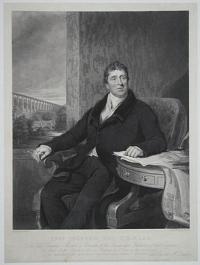
Thos. Telford, Esq. F.R.S.L.&E. To the Vice Presidents, Members, & Associates of the Incorporated Institution of Civil Engineers. This Print of the President from a Painting by S. Lane in their possession is dedicated with permission by their most obedient Servants Edwd. @Turrell & W. Raddon.
Painted by S. Lane. Engraved by W. Raddon.
London Jany. 10, 1831, Published by Edmd. Turrell 46 Clarendon Street, Sommers Town W Raddon, 38 Kidmouth Street Regent Square and by the Sectry. of the Institution of Civil Engineers Buckingham Street Strand.
Engraving on india paper, title in open letters, rare. Image 335 x 270mm, 13¼ x 10½". Trimmed to plate; laid to card, some repairs and discolouration to the paper.
Thomas Telford (1757 - 1834), civil engineer, seated and looking away to right, with left hand on papers and charts on a round table beside him, right hand on the arm of his chair, holding spectacles; a view of the Pontcysylte Aqueduct in the background to left. Telford designed and built numerous canals, bridges, roads and harbours throughout Britain. His greatest engineering achievements include the Caledonian Canal and the Menai Bridge. He was a close friend of Thomas Campbell and Robert Southey. In 1820, he became the first president of the Engineers' Institute. After Samuel Lane (1780 - 1859). NPG D1381.
[Ref: 20888] £230.00
(£276.00 incl.VAT)
![Ja.s Walker 1846 [facsimile signature].](img-thumbnail/jpegs/48444.jpg)
Ja.s Walker 1846 [facsimile signature].
Engraved by Samuel Bellin.
[n.d., c.1850.]
Mezzotint on chine collé. 430 x 340mm (17 x 13½") very large margins.
James Walker (1781-1862), Scottish civil engineer whose works included: the West India and East India Docks with his uncle Ralph Walker; Commercial Road, which connected the West India Docks to the warehouses of the City; Greenland Dock; Surrey Commercial Docks; the West Usk Lighthouse (the first of 22); and the completion of the Caedonian Canal. He succeeded Thomas Telford as President of the Institution of Civil Engineers (1834-45).
[Ref: 48444] £240.00
(£288.00 incl.VAT)
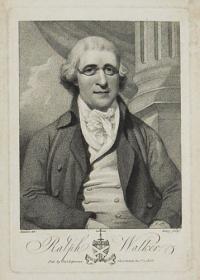
Ralph Walker.
Eckstien del. Ridley, sculp.t.
Pub by Ja.s Asperne 32, Cornhill Dec.r 1, 1803.
Stipple. 160 x 110mm (6¼ x 4¼") large margins. Edges spotted.
Ralph Walker (1749-1824), Scottish civil engineer. He was appointed resident engineer of the West India Docks in August 1799; engineer to the East India Docks Company (working with John Rennie) in 1803; engineer for the Surrey Commercial Docks Company in 1807; and engineer to the East London Waterworks Company, 1807-24.
[Ref: 43395] £60.00
(£72.00 incl.VAT)
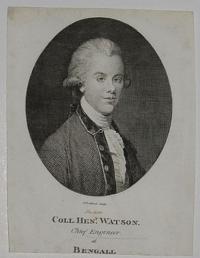
The Late Coll. Hen.y Watson. Chief Engineer of Bengal.
T. Prattent Sculp.
[n.d. c.800.]
Etching and stipple. 128 x 100mm. 5 x 4". Trimmed and laid on card.
Col. Henry Watson (1737-1786), Chief Engineer to the Company, established Bengal's first dockyard in Khidirpur. He is linked with Fort William and brought about many improvements in Calcutta, including the layout of surrounding Esplanade.
[Ref: 26037] £65.00
(£78.00 incl.VAT)
![James Watt [facsimile signature.]](img-thumbnail/jpegs/15388.jpg)
James Watt [facsimile signature.]
E. Finden, sculpt.
[n.d., c.1835.]
Stipple on india laid paper, 280 x 225mm. 11 x 9".
James Watt (1736 - 1819), engineer, a profile view of the sculptured bust by Sir Francis Chantrey (1782 - 1841). A mechanical engineer who trained as a mathematical instrument-maker, James Watt invented the condensing steam-engine in 1765. He took Matthew Boulton as his partner in 1775, and developed an improved version of this engine which revolutionised industry and immortalised Watt's name, inaccurately but effectively, as the 'inventor of the steam-engine'. Inscribed 'Proof' lower left. Wellcome: 3128-12.
[Ref: 15388] £60.00
(£72.00 incl.VAT)
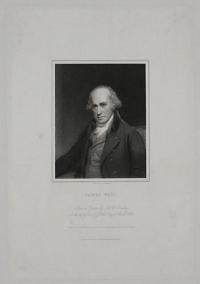
James Watt.
Engraved by C. E. Wagstaff. From a picture by Sir W. Beechey in the possesion of J. Watt Esq. of Aston Hall.
London. Published by Charles Knight, Pall Mall East. [n.d., c.1845].
Stipple with etching. Laid on India paper. Proof. Platemark: 290 x 192mm (11½ x 7½"). Very large margins.
Portrait of engineer James Watt (1736 - 1819). A mechanical engineer who trained as a mathematical instrument-maker, James Watt invented the condensing steam-engine in 1765. He took Matthew Boulton as his partner in 1775, and developed an improved version of this engine which revolutionised industry and immortalised Watt's name, inaccurately but effectively, as the 'inventor of the steam-engine'. From Watt Collection Sotheby.
[Ref: 32616] £70.00
(£84.00 incl.VAT)
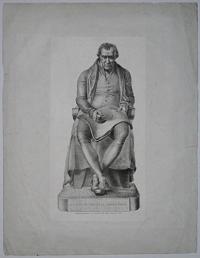
Statue of the Late James Watt.
F. Chantrey RA. Drawn by Permission, on Stone from the Marble Statue, by I. Zeitter.
[n.d., c.1820s.]
Lithograph on india paper, scarce, india 320 x 165mm. 12½ x 6½".
James Watt Memorial: In 1825 a very large white marble statue was erected in St Paul’s chapel in Westminster Abbey in memory of James Watt, civil engineer. It was made by Sir Francis Chantrey and cost over £6,000. The introduction of this colossal monument into the little chapel meant that the pedestal had to be divided into three pieces and was dragged in over the medieval tomb of Sir Lewis Robessart, destroying the ancient coffin lid. The statue only just went through the door and the floor gave way under its weight and disclosed “rows upon rows of gilded coffins” beneath. Had the area not been planked over the workmen and the statue would have fallen in. The epitaph was by Lord Brougham and read: “Not to perpetuate a name which must endure while the peaceful arts flourish, but to shew that mankind have learned to know those who best deserve their gratitude. The King, His Ministers, and many of the Nobles and Commoners of the Realm raised this monument to JAMES WATT who, directing the force of an original Genius, early exercised in philosophic research, to the improvement of the Steam Engine, enlarged the resources of his Country, increased the power of Man, and rose to an eminent place among the most illustrious followers of science and the real benefactors of the World. Born at Greenock MDCCXXXVI Died at Heathfield in Staffordshire MDCCCXIX.” In 1960 the statue was removed from the Abbey and a bronzed plaster bust was given in its place by the Institution of Mechanical Engineers. The bust stands on the window ledge in the north choir aisle and a memorial stone was inserted in the floor of St Paul’s chapel to mark the site of the statue, with the same inscription as above carved on it. The Chantrey statue is now at the Scottish National Portrait Gallery.
[Ref: 21981] £220.00
(£264.00 incl.VAT)

Joseph Wilkes.
Painted by Thomas Walker. Engraved by George Clint.
London.Published, Decr.1.1893, by T.Walker 32, Grafton St. Fitzroy Sqr.
Mezzotint. Plate 359 x 270mm.
Engineer, Canal Builder. Died at Croydon in 1805.
[Ref: 6388] £260.00
(£312.00 incl.VAT)
<<< Previous 1 Next >>>



![Matth:w Boulton [facsimile signature.]](img-thumbnail/jpegs/26644.jpg)





![[John Buddle, Esq.r.]](img-thumbnail/jpegs/57096.jpg)

![W. Cubitt [facsimile signature]](img-thumbnail/jpegs/4010.jpg)



![Peter Ewart [facsimile signature]. Private Plate[lower left].](img-thumbnail/jpegs/3953.jpg)

![[John Hawkshaw.]](img-thumbnail/jpegs/8207.jpg)
![[Thomas Hawksley] T. Hawksley [facsimile signature.]](img-thumbnail/jpegs/47445.jpg)



![W.H. Phillips [facsimile signature]](img-thumbnail/jpegs/35334.jpg)
![[James Meadows Rendel, F.R.S.]](img-thumbnail/jpegs/22531.jpg)


![William Siemens [facsimile signature].](img-thumbnail/jpegs/43389.jpg)




![GW: Stephenson Engineer. [facsimile signature]](img-thumbnail/jpegs/946.jpg)

![GW: Stephenson Engineer. [facsimile signature]](img-thumbnail/jpegs/947.jpg)
![Geo Stephenson [facsimile signature].](img-thumbnail/jpegs/3966.jpg)
![[Robert Stephenson].](img-thumbnail/jpegs/380.jpg)
![[Robert Stephenson, Esq.re M.P.]](img-thumbnail/jpegs/3968.jpg)
![T. Telford Esqr [ink mss.]](img-thumbnail/jpegs/12294.jpg)

![Ja.s Walker 1846 [facsimile signature].](img-thumbnail/jpegs/48444.jpg)


![James Watt [facsimile signature.]](img-thumbnail/jpegs/15388.jpg)


